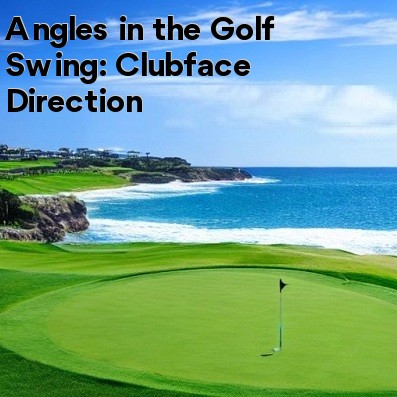
Angles in the Golf Swing: Clubface Direction
Golf is a game of precision, and one of the most critical factors in achieving accuracy is the clubface direction. The position of the clubface at impact greatly determines the direction and flight of the ball. Understanding the concept of clubface direction and how it affects your shots is essential for improving your game.
When we talk about clubface direction, we refer to the angle of the clubface at the moment of impact with the ball. It can be open, closed, or square. An open clubface points to the right of the target line, a closed clubface points to the left, and a square clubface aligns with the target line.
Having a square clubface at impact is ideal for achieving straight shots. When the face contacts the ball squarely, it imparts no sidespin on the ball, resulting in a more accurate and predictable flight. An open or closed clubface, on the other hand, introduces sidespin, causing the ball to curve either to the right or left.
So, how can you ensure a square clubface at impact? Firstly, it starts with proper grip. Holding the club correctly allows you to control the clubface throughout the swing. Make sure your hands and wrists are in the proper position, with the face square to your target, before starting your backswing.
Another important aspect to consider is your swing path. The path refers to the direction the clubhead travels during the swing. A swing path that is too much inside-out tends to produce a closed clubface at impact, resulting in shots that curve left for a right-handed golfer or right for a left-handed golfer. Conversely, an outside-in swing path often leads to an open clubface at impact, causing shots to veer right for a right-handed golfer or left for a left-handed golfer.
To promote a square clubface, work on an on-plane swing. This means your club should follow a path that matches your shoulder turn, enabling the clubface to align with the target line efficiently. Practicing with alignment aids such as alignment sticks or training aids can help you develop a better understanding of your swing path and clubface orientation.
Moreover, maintaining a consistent rhythm and tempo is crucial for a square clubface. Rushing your swing or decelerating through impact can lead to misalignment of the face at impact. Focus on maintaining a smooth and balanced swing throughout to achieve more accurate clubface contact.
clubface direction is one of the most important angles in the golf swing. The clubface angle at impact is critical for hitting the ball solid and accurately.
The clubface should be square to the target at impact. This means that the face of the club should be perpendicular to the target line. If the clubface is open, the ball will slice. If the clubface is closed, the ball will hook.
There are a few things you can do to ensure that the clubface is square at impact:
- Make sure your grip is correct. A good grip will help you to control the clubface throughout the swing.
- Keep your wrists firm at impact. This will help you to square the clubface at impact.
- Don't try to force the clubface closed with your hands. Let the clubface close naturally as you swing through impact.
- Practice regularly. The more you practice, the better you will become at controlling the clubface angle at impact.
Here are some common mistakes to avoid when it comes to clubface direction in the golf swing:
- Having an incorrect grip. A bad grip can make it difficult to control the clubface throughout the swing.
- Not keeping the wrists firm at impact. This can cause the clubface to open or close at impact.
- Trying to force the clubface closed with the hands. This can lead to a loss of power and accuracy.
By following these tips, you can learn to control the clubface direction in your golf swing and hit the ball more consistently.
Here are some additional tips for keeping the clubface square at impact:
- Use a mirror or alignment stick to check your clubface alignment at address. This will help you to make sure that you are starting with the clubface square to the target.
- Practice hitting balls with a purpose of hitting the ball straight. This will help you to develop the muscle memory needed to square the clubface at impact.
- Get lessons from a qualified golf instructor. A good instructor can help you identify any flaws in your swing and develop a plan to improve your clubface control.
With a little practice, you can learn to control the clubface direction in your golf swing and hit the ball more consistently.
Lastly, being aware of your clubface direction during the swing is essential. Visualizing the target and picturing the clubface aligning with it can help you achieve better clubface control. Regularly practicing with video analysis or with the help of a coach can also assist in identifying and correcting any clubface alignment issues.
In conclusion, understanding and controlling clubface direction is a fundamental aspect of the golf swing. A square clubface at impact leads to straight and accurate shots, while an open or closed clubface can cause the ball to curve. By focusing on proper grip, swing path, rhythm, and awareness of clubface orientation, you can improve your clubface control, ultimately enhancing your overall game.
Q&A:
Q1: How does the clubface direction impact the ball's flight? A: The clubface direction at impact primarily determines the initial direction of the ball. A closed face leads to a draw, while an open face results in a fade or slice.
Q2: What causes the clubface to be open or closed at impact? A: The clubface's alignment at address and how it rotates during the swing dictate its position at impact.
Q3: How does grip influence clubface direction? A: A strong grip tends to close the clubface, while a weak grip opens it. Finding the right grip for your desired shot shape is crucial.
Q4: Can poor hand position affect clubface direction? A: Yes, incorrect hand placement can lead to improper clubface direction at impact. Proper hand positioning sets up the clubface for success.
Q5: How does wrist position affect clubface direction? A: The angle of your lead wrist at the top of the backswing greatly affects clubface orientation at impact.
Q6: How do body rotation and weight shift impact clubface direction? A: Proper body rotation and weight shift help maintain a square clubface through the swing, leading to a more accurate shot.
Q7: What is the importance of alignment in controlling clubface direction? A: Proper alignment helps ensure that the clubface is square to the target at address, a critical factor in determining where the ball goes.
Q8: Can practicing with alignment aids improve clubface direction? A: Yes, alignment aids like alignment sticks can help you develop a consistent setup and clubface alignment, leading to better shots.
Q9: How does clubface direction affect shot trajectory? A: A closed clubface at impact can lead to a lower, draw shot, while an open face often produces a higher fade or slice.
Q10: Is it possible to manipulate clubface direction intentionally? A: Skilled golfers can manipulate the clubface through grip changes, wrist positions, and body rotations to achieve specific shot shapes.
Q11: How can I work on improving my clubface direction? A: Focus on alignment and grip. Practice drills that emphasize clubface control, such as hitting balls with a specific shot shape in mind.
Q12: Can clubface direction affect shot distance? A: Yes, if the clubface is significantly open or closed at impact, it can result in a loss of power and distance due to inefficient contact.
Q13: Is it better to slightly open or close the clubface for certain shots? A: Depending on the desired shot shape, slight adjustments to the clubface can help you achieve draws or fades.
Q14: Can technology help in monitoring clubface direction? A: Launch monitors and simulators provide real-time data on clubface angle at impact, helping you adjust and fine-tune your swing.
Q15: What's the key takeaway regarding clubface direction? A: Controlling clubface direction is essential for consistent shotmaking. Work on your grip, alignment, and body rotation to achieve desired results.






